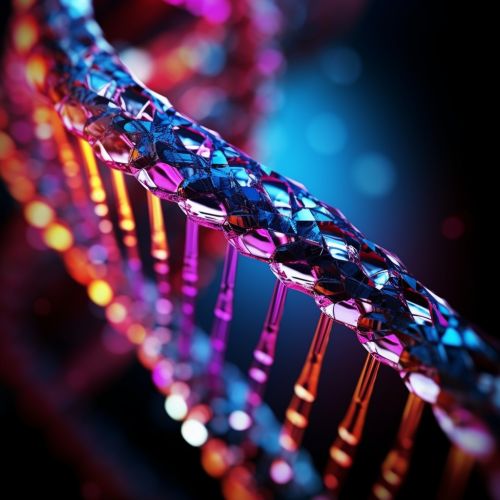Non-homologous end joining
Overview
Non-homologous end joining (NHEJ) is a pathway that repairs double-strand breaks in DNA. It is referred to as "non-homologous" because the break ends are directly ligated without the need for a homologous template, in contrast to the homologous recombination repair pathway. NHEJ is considered an error-prone process as it often results in the loss or gain of a few base pairs at the site of the break.


Mechanism
The NHEJ process is initiated by the binding of the Ku heterodimer to the DNA ends. This is followed by the recruitment of the DNA-dependent protein kinase catalytic subunit (DNA-PKcs), which activates end processing enzymes. The DNA ends are then processed by nucleases and polymerases, and finally ligated by the XRCC4/Ligase IV complex.
DNA End Recognition
The Ku heterodimer, consisting of Ku70 and Ku80 subunits, binds to the DNA ends with high affinity. This binding is not sequence-specific, allowing NHEJ to repair a wide range of DNA breaks. The Ku heterodimer also serves as a scaffold for the recruitment of other NHEJ proteins.
Recruitment of DNA-PKcs
Following the binding of the Ku heterodimer, DNA-PKcs is recruited to the DNA ends. DNA-PKcs is a serine/threonine protein kinase that plays a crucial role in the NHEJ pathway. It phosphorylates several proteins involved in NHEJ, including itself, which is thought to regulate the end processing and ligation steps.
DNA End Processing
The DNA ends are processed by a variety of nucleases and polymerases. The Artemis nuclease, activated by DNA-PKcs, trims the DNA ends to make them ligatable. DNA polymerases μ and λ, along with terminal deoxynucleotidyl transferase (TdT), can add nucleotides to the DNA ends if necessary.
DNA Ligation
The final step in the NHEJ pathway is the ligation of the DNA ends. This is carried out by the XRCC4/Ligase IV complex, which is stabilized by the accessory factors XLF and PAXX. The ligation step is crucial for the completion of NHEJ and the restoration of DNA integrity.
Role in V(D)J Recombination
NHEJ plays a crucial role in V(D)J recombination, a process that generates diversity in B-cell and T-cell receptors in the immune system. During V(D)J recombination, the RAG complex introduces double-strand breaks at specific sites in the DNA. These breaks are then repaired by the NHEJ pathway, leading to the joining of different V, D, and J gene segments.
Role in Class Switch Recombination
In addition to V(D)J recombination, NHEJ is also involved in class switch recombination (CSR), a process that changes the class of antibodies produced by B cells. During CSR, activation-induced cytidine deaminase (AID) induces double-strand breaks in the switch regions of the immunoglobulin genes. These breaks are then repaired by the NHEJ pathway, resulting in the switching of antibody classes.
Role in Genome Stability
NHEJ is crucial for maintaining genome stability. It repairs double-strand breaks that can be induced by various factors, such as ionizing radiation, oxidative stress, and replication errors. Defects in the NHEJ pathway can lead to genomic instability and predispose to cancer.
Clinical Significance
Defects in the NHEJ pathway can lead to several genetic disorders, including severe combined immunodeficiency (SCID), radiosensitive SCID, and LIG4 syndrome. These disorders are characterized by immunodeficiency, radiosensitivity, and a predisposition to lymphoid malignancies. In addition, mutations in NHEJ genes have been found in several types of cancer, suggesting a role for NHEJ in tumorigenesis.
